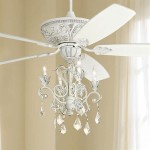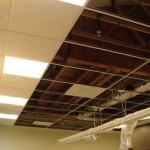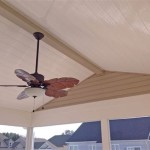Installing a Ceiling Fan on a Vaulted Ceiling: A Comprehensive Guide
Installing a ceiling fan on a vaulted, or sloped, ceiling presents a unique set of challenges compared to a standard flat ceiling. The angle necessitates specialized mounting hardware and careful planning to ensure the fan operates safely, efficiently, and aesthetically. This article provides a detailed, step-by-step guide to properly installing a ceiling fan on a vaulted ceiling.
Before undertaking the installation process, it is crucial to prioritize safety. Disconnecting the power to the circuit is paramount, and using appropriate safety equipment, such as eye protection and gloves, is highly recommended. Furthermore, familiarity with electrical wiring and building codes is essential. If unsure, engaging a qualified electrician is the safest course of action.
The first step involves selecting the appropriate ceiling fan and mounting kit. Not all ceiling fans are designed for sloped ceilings. Look for models explicitly marketed as suitable for vaulted or angled installations. These fans typically offer features like longer downrods and adjustable mounting brackets to accommodate the slope. The National Electrical Code (NEC) might have specific requirements for installing ceiling fans, so consulting the local building department is advisable.
Key Point 1: Selecting the Correct Mounting Hardware
The mounting hardware is the most crucial element for a safe and functional vaulted ceiling fan installation. A standard ceiling fan mounting bracket is insufficient for a sloped ceiling. Instead, a specialized mounting kit, often referred to as a "vaulted ceiling adapter" or "sloped ceiling kit," is required. These kits typically include a mounting bracket specifically designed to accommodate various ceiling angles, a longer downrod to suspend the fan further away from the ceiling, and hardware for secure attachment.
The angle of the vaulted ceiling is a critical factor in selecting the correct mounting kit. Most kits are designed for a specific range of angles, so accurately measuring the ceiling slope is essential. A protractor or angle finder can be used to determine the precise angle. Once the angle is known, choose a mounting kit that is compatible with that specific angle range. Some kits are adjustable, allowing them to be used for a wider range of ceiling slopes.
The weight of the ceiling fan is another important consideration. Ensure that the mounting kit is rated to support the weight of the chosen fan. Exceeding the weight limit of the mounting kit can lead to instability and potential safety hazards. The mounting kit should be secured to a structural ceiling joist or brace. If the existing electrical box is not appropriately rated or positioned, it may need to be replaced or relocated. Always consult local building codes to ensure compliance when moving or updating an electrical box.
When selecting a downrod, consider the height of the ceiling and the desired clearance between the fan blades and the floor. Building codes usually specify a minimum clearance height. A longer downrod will lower the fan, bringing it closer to the floor and potentially improving airflow, while a shorter downrod will keep the fan closer to the ceiling. Choose a downrod length that provides optimal airflow and meets safety requirements.
Inspect the chosen mounting kit for quality and durability. Look for kits made from heavy-duty steel or other robust materials. The hardware should be corrosion-resistant to prevent rust and ensure long-lasting performance. Read reviews and consult with professionals to determine the most reliable and well-regarded mounting kits on the market.
Before purchasing the mounting kit, verify that it is compatible with the chosen ceiling fan. Some fans require specific mounting kits, while others are more versatile. Check the fan's specifications and the mounting kit's compatibility list to ensure a proper fit. If unsure, contact the manufacturer of the fan or mounting kit for clarification.
Key Point 2: Preparing the Electrical Wiring and Mounting Location
Electrical safety is paramount. Before commencing any electrical work, disconnect the power to the circuit at the breaker box. Verify that the power is off using a non-contact voltage tester. Work in a well-lit area and adhere to all electrical safety codes and regulations. If unsure about any aspect of the electrical wiring, consult a qualified electrician.
Inspect the existing electrical box in the ceiling. It must be rated for supporting the weight of a ceiling fan. Standard electrical boxes are typically not designed to handle the dynamic load of a rotating fan. Look for a box specifically designed for ceiling fans, often labeled "fan-rated" or "ceiling fan support box." These boxes are reinforced and secured to the structural framing of the ceiling to provide adequate support.
If the existing electrical box is not fan-rated, it must be replaced. This process involves removing the old box, carefully detaching the wiring, and installing the new fan-rated box. Secure the new box directly to a ceiling joist or brace using appropriate screws or nails. Ensure that the box is flush with the ceiling surface and properly aligned for the mounting bracket.
The location of the electrical box is also important. Ideally, it should be positioned directly above the center of the room or the area where the fan is to be installed. If the location is not ideal, it may be necessary to run new wiring to a more suitable location. This task is best left to a qualified electrician to ensure compliance with electrical codes and safety standards.
Once the electrical box is properly installed, prepare the wiring for connection to the ceiling fan. Typically, there will be three wires: a black (hot) wire, a white (neutral) wire, and a green or bare (ground) wire. Strip the ends of the wires to expose approximately 1/2 inch of bare wire. Use wire connectors to securely attach the fan's wires to the corresponding wires in the electrical box. Ensure that all connections are tight and secure to prevent loose wires, which can cause electrical problems.
Before proceeding further, test the wiring to ensure that it is properly connected and functioning correctly. Turn the power back on at the breaker box and use a voltage tester to verify that the black wire is carrying voltage. Then, turn the power back off and proceed with the installation of the mounting bracket.
Key Point 3: Installing the Mounting Bracket and Fan Assembly
With the electrical wiring and mounting location properly prepared, the next step is to install the vaulted ceiling adapter and mounting bracket. Attach the adapter to the ceiling joist, ensuring it is securely fastened. This will be the foundation for the fan's mounting bracket. Follow the manufacturer's instructions for the specific adapter being used.
Secure the mounting bracket to the vaulted ceiling adapter. Ensure it is aligned and tightened according to the manufacturer's instructions. A level can be used to verify that the bracket is horizontal. This step is critical to prevent the fan from wobbling or vibrating excessively.
Carefully lift the fan motor assembly and attach it to the mounting bracket. This usually involves inserting the downrod through the canopy and into the mounting bracket, then securing it with a pin or screws. Ensure that the downrod is properly seated and securely fastened to the bracket. The extended downrod is crucial for vaulted ceilings as it keeps the fan blades a safe distance from the angled ceiling itself, preventing any potential contact or interference.
Connect the electrical wiring from the ceiling fan to the corresponding wires in the electrical box. Use wire connectors to make secure connections. Push any excess wire back into the electrical box. Carefully position the canopy to cover the mounting bracket and secure it to the ceiling. The canopy serves a cosmetic purpose, hiding the bracket and wiring, while also providing a finished look.
Attach the fan blades to the motor assembly. This usually involves screwing the blades to the motor using the provided hardware. Ensure that the blades are securely fastened and properly balanced. Uneven blade attachment can cause wobbling or vibrations during operation. Many fans come with a blade balancing kit, which can be used to fine-tune the balance of the blades and eliminate any wobbling.
Install the light kit, if included. Follow the manufacturer's instructions for wiring and attaching the light kit. Ensure the light kit is securely fastened and that all connections are properly made before securing the glass or shade. Test the light kit to verify proper functionality.
Once the fan assembly is complete, turn the power back on at the breaker box. Test the fan to ensure that it is operating correctly. Check the fan speeds and direction to ensure proper functionality. If the fan wobbles excessively, use the blade balancing kit to fine-tune the balance of the blades. Inspect the fan for any loose screws or connections and tighten them as needed.
Finally, clean up the work area and dispose of any waste materials properly. Ensure that all tools and equipment are put away and that the area is safe and free of hazards.
Installing a ceiling fan on a vaulted ceiling requires careful planning, attention to detail, and adherence to safety guidelines. By following these steps and taking the necessary precautions, a ceiling fan can be safely and effectively installed on a vaulted ceiling, providing improved air circulation and enhanced aesthetics.

How To Install A Ceiling Fan On Sloped Lemon Thistle

How To Choose A Ceiling Fan For Vaulted Ceilings Lightology

Ensuring Proper Ceiling Fan Installation With Vaulted Ceilings

How To Install A Ceiling Fan On Sloped Lemon Thistle

How To Choose A Ceiling Fan For Vaulted Ceilings Lightology

Fans On An Angle Installing Ceiling Angled Or Raked

How To Choose A Ceiling Fan For Vaulted Ceilings Lightology

How To Install Vaulted Ceiling Fan

Smart Choice For A Ceiling Fan

How To Install A Ceiling Fan On Sloped Lemon Thistle
Related Posts








